
1. Get into pairs/groups and match the columns :
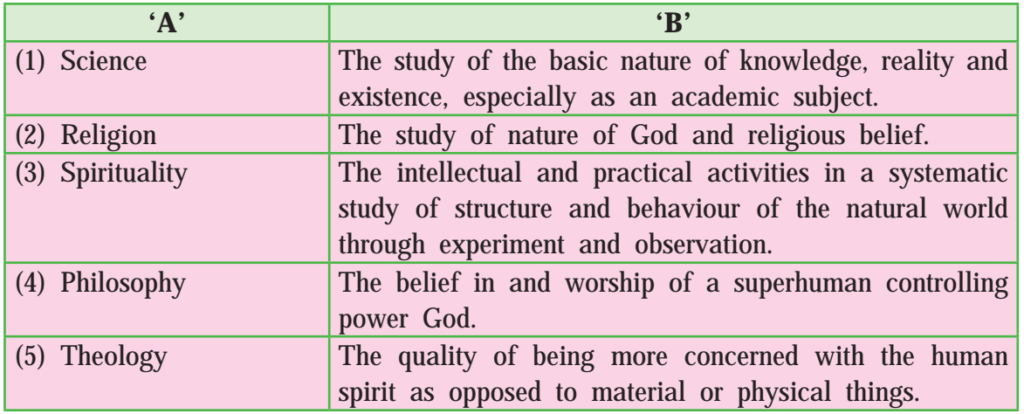
Ans.
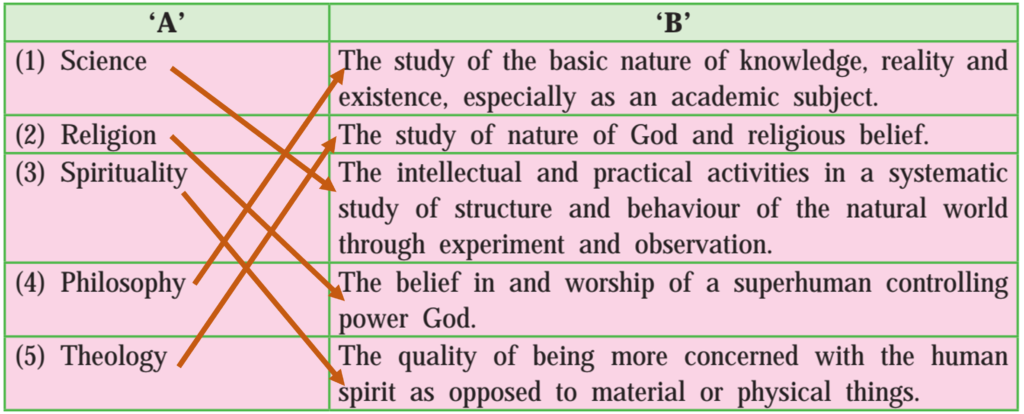
2. Given below are some incomplete Quotes. Complete them choosing from the words SCIENCE /RELIGION/SPIRITUAL and make them meaningful :
♦ ………………… without religion is lame; ………………… without science is blind.
♦ ………………… has outrun our ………………… power, we have guided missiles, but misguided man.
♦ On a ………………… journey, we all have the same destination.
♦ ………………… is meant to awaken man’s love for his Source – God !
♦ ………………… provides a means of with the Creator of Heaven and Earth, in the language of your heart and soul.
♦ ………………… is a beautiful gift to humanity; we should not distort it.
Ans. (i) Science, Religion (ii) Science, spiritual (iii) Spiritual (iv) Religion (v) Religion (vi) Science
The difference between science and technology is that the goal of science is the pursuit of knowledge for its own sake while the goal of technology is to create products that solve problems and improve human life. Technology is the practical application of science.
4. Do you think that science and faith are both important in our lives ? Why ? Discuss in your group and give a small presentation in front of the class.
Yes, I think that science and faith are both important in our lives. To believe in science you have to have faith because unless you have faith, science of anything cannot be proved.


6. Refer to a dictionary to find out the meanings of the following words.
Spirit – a person’s mind or feelings or soul.
♦ Spiritual
♦ Spirituality
♦ Spiritualism
♦ Spiritualist
Spirit : a person’s mind of feelings or soul.
Spiritual (adj) : relating to religion or religious belief.
Spirituality (noun) : the quality of being concerned with the human spirit or soul as opposed to material or physical things.
Spiritualism (noun) : the belief that living people can communicate with people who have died.
Spiritualist (noun) : a person who believes that the spirits of the dead can communicate with living people.
… FACTUAL QUESTIONS …
Why do science and faith have to go hand in hand ?
Ans. Science and faith have to go hand in hand for the good of humanity.
Why was the site in Thumba selected for building the space research centre?
Ans. A site in Thumba, Kerala was selected to set up the space research center because of its proximity to the magnetic equator.
What shaped Dr Kalam’s thoughts on religion?
Ans. Dr. Kalam’s interactions with the great scientist Dr. Vikram Sarabhai and the Reverend Father Peter Bernard Pereira shaped his thoughts on religion.
What was the major obstacle in getting possession of the site?
Ans. A site in Thumba, Kerala was selected by Dr. Sarabhai and his team to set up their space research center due to its proximity to the magnetic equator. This site was the fishing grounds of Thumba’s fisherman. It also housed an old church, a bishop’s house and a school. Relocating so many people from the site and destroying religious institutions for the sake of a space research center seemed to be the major obstacle in getting possession of the site.
Who helped to solve the problem of acquiring the site?
Ans. Reverend Father Peter Bernard Pereira helped Dr. Kalam and Dr. Sarabhai in solving the problem of acquiring the site.
How did the people respond to the appeal made by Rev. Pereria ? Would you have given the same response ?
Ans. When Father Pereira spoke and there was a pin drop silence in the church for a long moment. Then everyone got up, and the whole church reverberated with the deafening noise of a collective ‘amen’ which meant ‘so be it’.
If I was in the similar situation faced by the people in the passage, I would have been very scared and worried at the beginning, but then after understanding the importance of the situation, I would have given my approval for the same.
How can we lead a pure life?
Ans. We can lead a pure and ethical life by removing the impurities obscuring our souls and by serving humanity.
Whose philosophy actually had an impact on the writer?
Ans. APJ Abdul Kalam’s philosophy actually had a great impact on the writer because he realised that through his words of wisdom he was getting to learn from countless great minds.
What advice did Dr Kalam give the narrator after his graduation ?
Ans. Srijan, the narrator had met Dr. Kalam after he graduated from IIMA in 2009. At that time, Dr. Kalam advised him to use his degree and gold medal to transform the society he lived in.
What was Mahaswamiji’s tremendous contribution ?
Ans. Mahaswamiji’s tremendous contribution was the establishment of a free residential education system for more than nine thousand children in the ashram.
What was unique about Mahaswamiji ?
Ans. The most unique thing about Mahaswamiji was that while celebrating his 102nd birthday, an age which only 4 out of a lakh reach, he stood on his feet throughout the event without any support and looked as steady and alert as any youngster present for the birthday celebrations.
What was the secret of Mahaswamiji’s fitness even at the age of 102 years ?
Ans. Mahaswamiji’s spirit of ‘What Can I Give’ wherein he feeds famished minds with beliefs and famished bodies with food, feeds his strength and keeps him strong. This was the secret of his fitness even at the age of 102.
What makes society corrupt and unfair ?
Ans. The attitude and thought “What can I take? from the environment and other humans” makes a society corrupt and unfair.
Which question inspires humanitarianism?
Ans. “What can I Give?” is the question which inspires humanitarianism.

1. (A) Read ‘Part I’ and match the words in Column ‘A’ with associating words given in Column ‘B’.
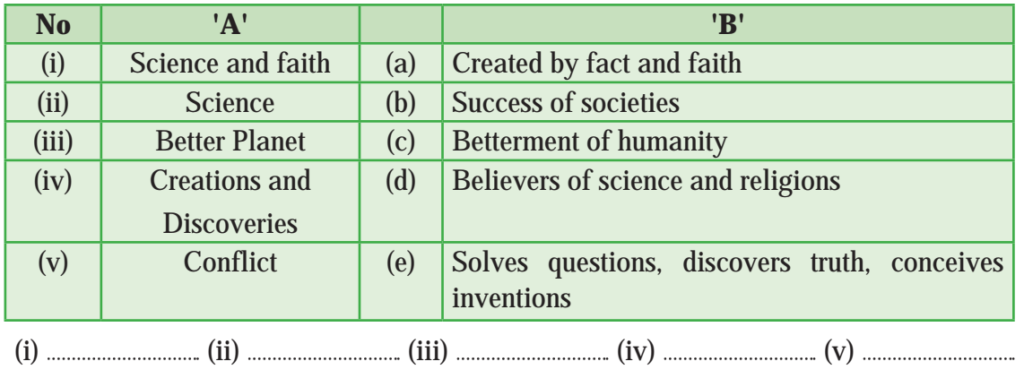
Ans. (i – c), (ii – e), (iii – a), (iv – b), (v – d)
(B) Read ‘Part II’. Go through the given statements and say whether you agree or disagree to each of them.
(a) The Space Research set up facility was planned at Allapi, Kerala – …………………………………
(b) The person who could help and can be contacted was the Bishop – …………………………………
(c) It was quite easy to relocate so many people and destroy religious institutions for spaceresearch centre – …………………………………
(d) Dr. Kalam joined ISRO in 1970 – …………………………………
(e) Science and spirituality seeks prosperity of the human life – …………………………………
Ans.
(a) Disagree (b) Agree (c) Disagree (d) Disagree (e) Agree
(C) Go through ‘Part III’ and complete the following statements.
(a) The essence of a happy life and a peaceful society lies in one sentence – ……………………………..
(b) To keep this planet liveable and the human race thriving, we have to ……………………………..
(c) Mahaswamiji’s greatest contribution is the ………………………………
(d) We can remove the impurities obscuring our souls by ………………………………
(e) The narrator, Srijan, realised that through Dr. Kalam’s words of wisdom ………………………………
(f) Mahaswamiji possesses powers that kept him so strong were …………………………….. or ……………………………..
Ans.
(a) What can I give?
(b) replace ‘what can I take with what can I Give?
(c) establishment of a free residential education system
for more that nine thousand children in the ashram.
(d) living pure and ethical lives serving humanity
(e) he was getting to learn from countless great minds.
(f) healthy life style or genetics
2. Choose the correct alternative for the given statements.
(A) Dr. Kalam’s father was an ……………………
(a) teacher
(b) scientist
(c) farmer
(d) imam.
(B) Dr. Kalam’s friends discussed on …………………….
(a) science and technology
(b) discoveries and inventions.
(c) science and spirituality
(d) community’s problems and solutions.
(C) According to Dr. Kalam, the need that is felt more than ever is …………………….
(a) a laboratory to conduct experiments.
(b) a new technology to find results.
(c) a dialogue among cultures, religions and civilizations.
(d) a dialogue between people of different professions.
(D) Dr. Kalam’s father was a symbol of …………………….
(a) trust and faith.
(b) simplicity and divinity
(c) teacher and disciple.
(d) father and friend.
(E) Spirituality takes care of …………………….
(a) education, teaching and learning.
(b) science, technology and sci-fi.
(c) confusion, misery or failure.
(d) crime, illiteracy and child labour.
(F) How can academic brilliance diminish ?
(a) by disturbance and frustration.
(b) by going off track
(c) by a coating of dust.
(d) by losing focus and seriousness.
(G) What was most astonishing about 102 year old Swamiji?
(a) He was a great speaker and orator.
(b) He was a great scientist.
(c) He was a great admirer of technology.
(d) He looked as steady and alert as any other youngster.
(H) What Dr. Kalam gathered while swimming in silence at the shores of Mahapragyaji?
(a) beautiful sea shores
(b) tree lined beaches
(c) sands of conscience
(d) beautiful sun-set.
Ans.
(a) imam
(b) Science and spirituality
(c) a dialogue among cultures, religions and civilizations
(d) simplicity and divinity
(e) confusion, misery or failure
(f) by losing focus and seriousness
(g) He looked as steady and alert as any other youngster
(h) sands of conscience
3. Among the three parts, there are people who touched and influenced the life of Dr. A. P. J. Kalam in one or the other ways. Complete the web chart by writing the names of such people.

Ans.
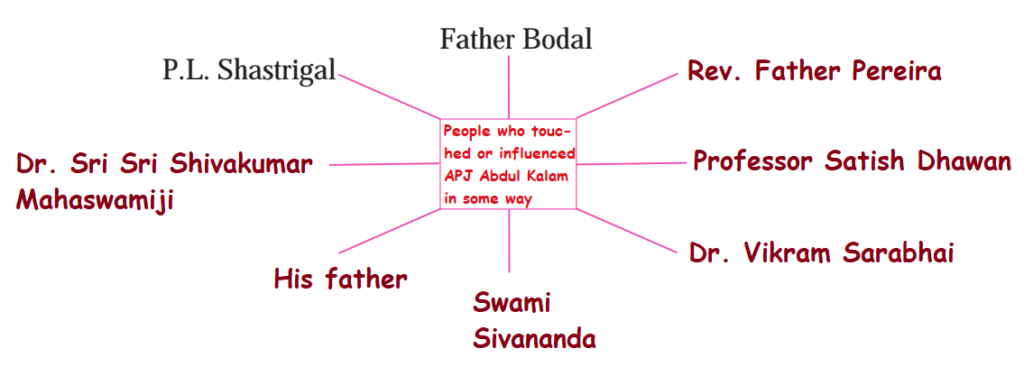
4. Write the significance of the following years, as given in the text.
1960 …………………………………………………………………………………………………………
1970 …………………………………………………………………………………………………………
1980 …………………………………………………………………………………………………………
2009 …………………………………………………………………………………………………………
2012 …………………………………………………………………………………………………………
Ans.
5. Who said to whom and when ?
(a) “Can we give up God’s abode for such a great scientific mission?”
…………………………………………………………………………………………………………..
(b) “And then God will shine through us.”
…………………………………………………………………………………………………………..
(c) “I wonder what power Mahaswamiji possesses, that keeps him so strong.”
…………………………………………………………………………………………………………..
(a) “Can we give up God’s abode for such a great scientific mission?”
Ans. Reverend father Pereira asked the people of Thumba at church after the prayer service.
(b) “And then God will shine through us.”
Ans. Dr. Abdul Kalam said these words to the narrator, Srijan when Srijan asked him how one could become so academically accomplished.
(c) “I wonder what power Mahaswamiji possesses, that keeps him so strong.”
Ans. The narrator, Srijan said the above lines to Dr. Abdul Kalam when they were discussing Mahaswamiji’s 102nd birthday.
6. Answer the following in your own words, and write in your notebook.
(a) What makes Dr Kalam a humble personality?
(b) How were different virtues inculcated in Dr Kalam ?
(c) How did the Reverend relate and compare the work that he and Dr Sarabhai
did for people?
(d) What was so remarkable about Dr Sri Sri Shivakumar Mahaswamiji?
(e) Why is there an urgent need to replace ‘What can I take’ with ‘What can I give?
Ans. (a) Even though Dr Kalam was indisputably a great scientist, he had deep faith and espoused the cause of the betterment of humanity. This shows that he was indeed a humble personality.
Ans. (b) Dr Kalam inculcated the virtue of humility from his father who was a boatman. He learnt from his father how simplicity and divinity could go together.
Ans. (c) The Reverend said that Dr Sarabhai was a scientist. We benefit from the devices that science has developed in many ways – in our homes and in the fields of medicine and technology. A priest prays for the peace and well-being of his people. Thus both science and spirituality seek the Almighty’s blessing for the prosperity of the human mind and body. In short, both are doing the same job.
Ans. (d) The remarkable aspect about Dr Sri Sri Shivakumara Mahaswamiji was that he had dedicated his life to the service of humanity.
Ans. (e) There is an urgent need to replace ‘What can I take’ with ‘What can I give’ for the very survival of humanity. Unless we realize the gravity of the message, this planet will become a hub of environmental degradation, social evils, inequity and corruption. If we do not take up the challenge, our planet will not be liveable and the human race will not prosper.
7. In your notebook, write a short paragraph on each of the following covering up their profession and personality traits with examples.
(a) Rev. Peter Bernard Pereira
(b) Dr Sri Sri Shivakumar Mahaswamiji
(c) Dr A. P. J. Abdul Kalam
Ans.
(a) Rev. Peter Bernard Pereira – He had leadership qualities which could inspire anybody. He was a selfless, dedicated person. He was a born leader. He was a priest in the St. Mary Magdalene Church, Thumba, Kerala. He understood the importance of science and that science and faith has to coexist with one another for the good of humanity. When approached by Dr Vikram Sarabhai to relocate the people and religious institutions from a site in Thumba wherein he preached, he was taken aback at first. Later on he convinced the people of Thumba to give up their abode and get relocated so that the research centre could be put up.
(b) Dr Sri Sri Shivakumar Mahaswamiji – He was from the Tumkur district of Karnataka. He was a remarkable person who dedicated his life to the service of humanity. At the ripe age of 102 he was able to stand throughout his birthday celebrations without any support. He was as fit and active as any other youngster present there. His greatest contribution is the establishement of a free residential education system which could accomodate more than nine thousand children in the ashram.
(c) Dr. A. P. J. Abdul Kalam – He was secular in his thoughts, because of his upbringing. He was an incredibly down to earth person and chose to live a very simple life. He attributes his humanity to his father. He was a firm believer in the almighty. Although being a scientist he believed in the fact that there is a super natural power which helps us in everything we do and for that, faith is very important and science and faith must co-exist for the good of humanity. He was extremely fascinated by the words of Mahaswamiji that the essence of a happy life and a peaceful society lies in one sentence- “What Can I Give?”Dr. Kalam brought this idea into reality in 2012 through the “What Can I Give Movement”.
8. Write in your own simple words what the following expressions convey in the context they occur in the text.
(a) Faith and fact can, together, create a better planet ……………………………………………………………………………………………………………………………………………………………………………………………………………………………………………
(b) Dr Kalam’s own life was nourished by multiple faiths …………………………………………………………………………………………………………………………………………………………………………………………………………………………………………….
(c) But there was a major roadblock …………………………………………………………………………………………………………………………………………………………………………………………………………………………………………….
(d) Only when the dust is removed, does the mirror shine and the reflection becomes clear …………………………………………………………………………………………………………………………………………………………………………………………………………………………………………….
(e) Through his (Kalam’s) words of wisdom, I was getting to learn from countless great minds …………………………………………………………………………………………………………………………………………………………………………………………………………………………………………….
(f) He gathered the sands of conscience to be our guide, our best friend …………………………………………………………………………………………………………………………………………………………………………………………………………………………………………….
(g) ‘What can I take?’ is the thought which is responsible for all the wrong, seen around us …………………………………………………………………………………………………………………………………………………………………………………………………………………………………………….
(a) Faith and fact can, together, create a better planet.
Ans. Inventions and discoveries and science are for the betterment of humanity. One must have positive faith in the facts of science which will go a long way in making a better world.
(b) Dr Kalam’s own life was nourished by multiple faiths –
Ans. Dr. Kalam grew up amidst people of different faiths, nourished himself with different cultures, religion, tradition and thought, moulding him into a wonderful person.
(c) But there was a major roadblock –
Ans. There was a major obstacle in getting the selected site.
(d) Only when the dust is removed, does the mirror shine and the reflection becomes clear –
Ans. The reflection on the mirror is cleared with the removal of dust. In the same way we live a pure and ethical life after removing the impurities that obscure our soul.
(e) Through his (Kalam’s) words of wisdom, I was getting to learn from countless great minds –
Ans. Dr Kalam’s interaction with great minds of different faiths could be seen and felt in his discourses.
(f) He gathered the sands of conscience to be our guide, our best friend –
Ans. Dr Kalam always did what his conscience told him to do because it is our conscience which tells us what to do and what not to, guiding us forever in our lives.
(g) ‘What can I take?’ is the thought which is responsible for all the wrong we see around us.
Ans. The greed of humans to only take from the environment and people without giving a thought about its repercussions result in the wrong we see around us.
9. (A) From the lesson, pick out one word for each of the following.
(a) increase the speed ………………………………………..
(b) point of view ………………………………………..
(c) nearness in space ………………………………………..
(d) a place of residence ………………………………………..
(e) eager to know everything ………………………………………..
(f) echoed loudly ………………………………………..
(g) giving away much to the needy ………………………………………..
(h) without making a difference ………………………………………..
Ans. (a) accelerate (b) perspective (c) proximity (d) abode (e) inquistive (e) reverberated (f) munificence (g) indiscriminately
(B) Arrange the following words in the alphabetical order.
inventions, indisputable, interactions, inequity, institutions, inquisitive, indiscriminately
Ans. (i) indiscriminately (ii) indisputable (iii) inequity (iv) inquisitive (v) institutions (vi) interactions (vii) inventions
(C) Find from the lesson the noun forms of –
1. combine …………………………………………
2. solve …………………………………………
3. simple …………………………………………
4. divine …………………………………………
5. advance …………………………………………
6. tranquil …………………………………………
7. liveable …………………………………………
8. strong …………………………………………
Ans.
(1) combination (2) solution (3) simplicity (4) divinity (5) advancement (6) tranquility (7) life (8) strength.
10. Match the word connectors with reference to part I, II, III respectively. Make sentences of each of these connectors.
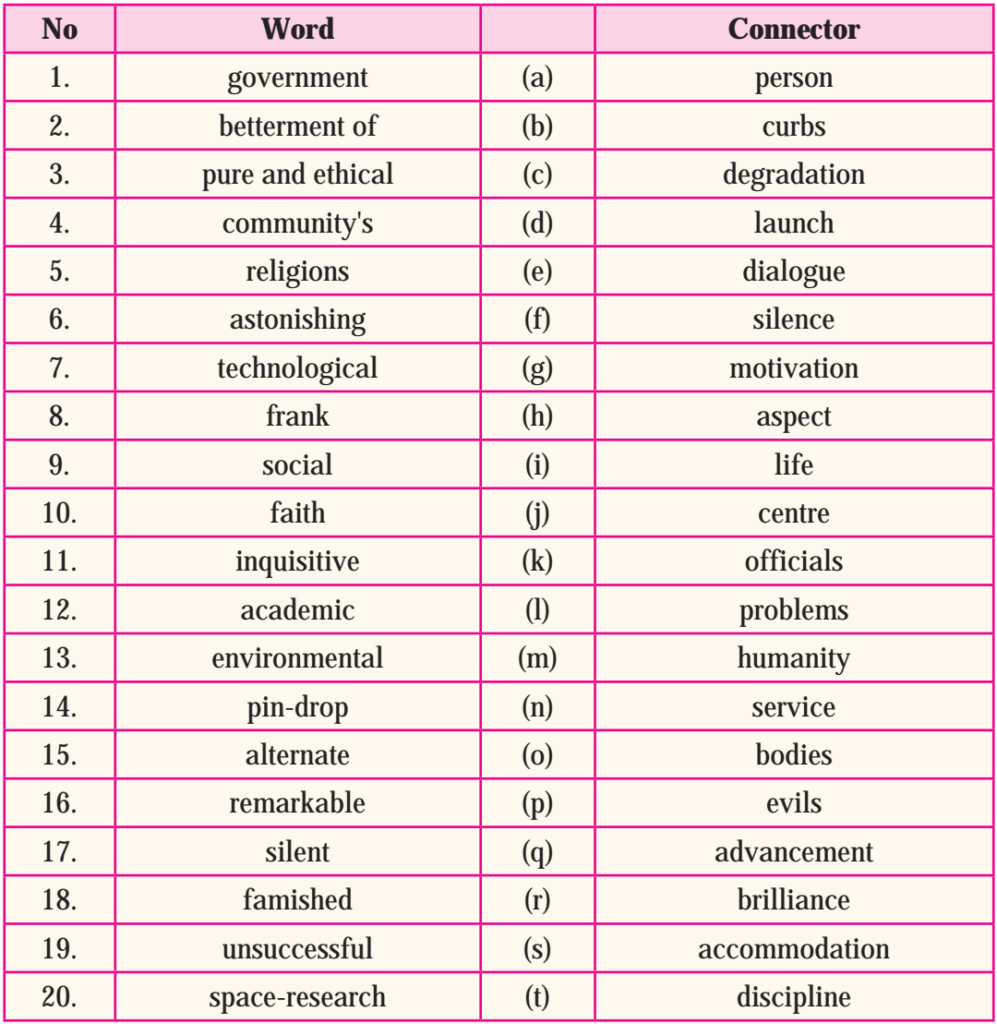
(1 – k), (2 – m), (3 – i), (4 – l), (5 – n), (6 – h), (7 – q), (8 – e), (9 – p), (10 – b), (11 – t), (12 – r), (13 – c), (14 – f), (15 – s), (16 – a), (17 – g), (18 – 0), (19 – d), (20 – j).
11. Simple sentence : subject + verb + object/complement/adverbial: Analysing a simple sentence is done by separating the subject and the predicate. The predicate is further analysed into –
(1) verb + object as in ‘A doctor treats patients’./ ‘He greeted the teacher.’
(2) verb + complement as in ‘They are very tired.’ / ‘I have a cold.’
(3) verb + adverbial as in (He walks slowly. / Raj arrived late. / The thief is hiding there.)
Say whether the predicates in the following sentences have an object/ a complement/an adverbial.
(1) There was silence …………………………
(2) Alexander Bell invented the telephone ………………………….
(3) They have a holiday ………………………….
(4) The dancer danced gracefully ………………………….
(5) The milkman comes daily ………………………….
(6) The hostess served tea ………………………….
(7) The kite soared upwards ………………………….
(1) complement (2) object (3) object (4) Adverbial (5) Adverbial (6) object (7) Adverbial
12. (A) Punctuate the following sentences to make them meaningful.
(1) dinesh took a bus that stopped at nanded railway station after crossing somvar peth
(2) dr a p j abdul kalam was the past president of india by the way he was a great
scientist orator and a humanitarian
(3) nouns are of different types common proper abstract concrete material
(4) what a lot of noise you all make said the teacher cant you keep quiet for a while
(5) wow how lovely that cake looks they said we cant wait to eat it
(1) dinesh took a bus that stopped at nanded railway station after crossing somvar peth
Ans. Dinesh took a bus that stopped at Nanded railway station, after crossing Somvar Peth.
(2) dr a p j abdul kalam was the past president of india by the way he was a great scientist orator and a humanitarian
Ans. Dr. A. P. J. Abdul Kalam was the past president of India. By the way, he was a great scientist, orator and a humanitarian.
(3) nouns are of different types common proper abstract concrete material
Ans. Nouns are of different types : Common, Proper, Abstract, Concrete, Material.
(4) what a lot of noise you all make said the teacher cant you keep quiet for a while
Ans. “What a lot of noise you all make!”, said the teacher. “Can’t you keep quiet for a while?”.
(5) wow how lovely that cake looks they said we cant wait to eat it
Ans. “Wow! How lovely that cake looks!” they said. “We can’t wait to eat it!”.
(B) Copy the first paragraph on page 92 in your notebook, carefully. Encircle all the puctuation marks with a coloured pencil/pen.
“Dear children …………………. ‘amen’.
‘Dear children, Dr. Vikram says that, within a year, he wants to build scientific facilities near the sea coast, replacing all the settlements that now stand there. Now, can you give up your abode? Can I give up my abode? Can we give up God’s abode for such a great scientific mission?’ Dr. Kalam recalled how he witnessed ‘a pin–drop silence for a long moment’. Then everyone got up, and the whole church reverberated with the deafening noise of a collective ‘amen’.
13. Project :
Read Dr. A.P.J. Abdul Kalam’s very renowned books ‘Wings of Fire’; and ‘Ignited Minds’, to find the following :
(a) Subject of the book
(b) Special features of the book
(c) Teachings/learnings/moral/message from the book
(d) Your own opinion/idea/comment on the book
Ans.
(i) Ignited minds by A.P.J. Abdul Kalam.
(a) Subject of the book: Motivating Indians especially the Indian youth to dream big and to believe that what they dream can be true.
(b) Special features of the book: It is a short book of 205 pages with 9 chapters. He writes why we are not developing as we should have and how we will become a developed country. He inspires the Indians to change the thinking and attitude of the country forging India to become a developed country.
(c) Teachings / learnings / moral/message from the book: The book consists of many inspirational messages from great people. This book is meant for Indian children, to ignite their thinking to think big for our country. Well inspired inspirational stories are provided in each of the chapters to encourage and build a spirit of oneness. It contains dynamic and original ideas, examines attitudes afflicting the Indians and presents prescription for the rapid growth of India to enable the country to emerge as a developed country.
(d) Our opinion / comment on the book: The book is written in simple language, very easy to understand and inspires everyone who reads it. The books is capable of igniting fire in the mind of anyone who reads and understands it.
(ii) Wings of Fire by APJ Abdul Kalam.
(a) Subject of the book: Wings of Fire is an autobiography of APJ Abdul Kalam former President of India. It was published in 1999 and it covers Kalam’s life before he became the President of India.
(b) Special features: The book covers his early life and his work in Indian space Research and missile programmes. It is the story of a boy from a humble background who went on to become a great scientist and later the President of India. The Book contains quotes which are very motivational. It also provides a glimpse of Indian harmony which existed before India’s partition. The book also contains many of his poems.
(c) Teachings/learnings/moral/message: One can find a glimpse of Kalam’s positive thinking throughout the book. He held many high ranking positions in various organizations, yet he has rarely mentioned anything about corruption or ignorance of bureaucracy or politicians. The secret to his success seems to be his ability to ignore negative things around him. APJ Abdul Kalam is simple, secular and inspiring.
(d) Our opinion / comment: Wings of fire is an autobiography of Dr. Kalam in simple language. His wordings helped and induced many youngsters that a fire exists in each and every one of us and it has to be utilized in the right way. How the young blood should react? What are our duties as a citizen? has been depicted very beautifully in simple but elegant words that has attracted many readers including me.
14. (A) Draft a speech that you would give at your School Assembly convincing junior students that the secret of true happiness lies in Giving and Sharing more than in Receiving and Taking.
Write it with the appropriate steps in your notebook.
Good morning, respected principal, teacher and my dear friends. I would like to start this wonderful day with a speech on the topic ‘The secret of true happiness lies in giving and sharing rather than receiving and taking.
We all know how great it feels to receive gifts. However this joy is short-lived. Our lives are richer when we share and that great inner joy comes from others. Giving blesses both the giver and the receiver. Giving and Sharing fills your life with joy and nourishes your soul, sharing and giving gives you a feeling of deep satisfaction that’s far more valuable than any gift. As Mahatma Gandhi said, “To find yourself, lose yourself in the service of others.” Giving and sharing takes you to a higher level. It is a quality of God himself, the ever giving. True joy is experienced when you give without expecting to receive something in return.
Making others happy gives you immense fulfillment and happiness in life which cannot be measured. Mother Teresa is a wonderful example. She found happiness in devoting her whole life to the sick dying lepers. She gave love and care and made their intolerable pain a little easier to bear. She cared and gave love to those sick and dying people who were disowned by their own kith and kin. Today she is anointed a saint. The happiness you get from taking and receiving is short lived. You keep expecting to get and receive and when you don’t you discover that you are unhappy because you have not received something. Giving and sharing is just the other way round, the more you give the more happiness you shall find.
So I would like to conclude by saying that I have also given and I have found true happiness; a happiness which makes you soar. Friends don’t take my word for it, try it once for yourself and see the difference.
Thank you and have a nice day sharing and giving.
(B) Divide your class in two groups and have a Debate on the topic ‘Science and Spirituality can go hand in hand’.
Use the points given, you can add your own too. Albert Einstein, the greatest scientist thinks that science and spirituality can work together…….
Why can’t we?
If we put God and Science together we can make more and more discoveries.
Religion is too broad and subjective a term to have a place in modern science.
God and science go hand – in – hand. God wants us and allows us to use science to better ourselves as humans.
Science can explain a lot of things except what came before our universe.
“If science and spirituality go hand-in-hand I’m sure one can create Heaven on Earth.” – Mahatma Gandhi.
Science focuses on faculties of reasoning and religion focuses on personal growth and love.
Many religious leaders note that scientific discoveries result from human intelligence and creativity which are gifts of God.